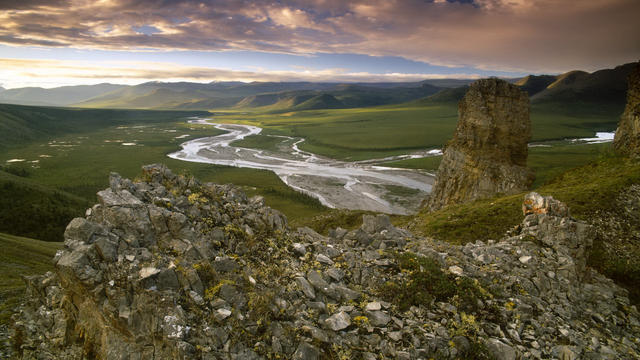Home » Regions » North America » Tundra
Tundra
Last updated: July 21st, 2020
To check where a specific point lies, you can look it up in our Ecoregion Locator.
↑Map Legend & Subregion List
This list will help you navigate the regions in case you have problems with viewing or clicking the interactive map above.
| Name | † | Color on Map |
| Northern Arctic | ○ | |
| Alaska Tundra | ○ | |
| Brooks Range Tundra | ○ | |
| Southern Arctic | ○ |
† Status: ✓ = Complete ○ = Needs Image … = Incomplete ∅ = Stub Only
↑Progress
Partially Complete | With Images | Complete w/ Images |
Get involved! You can help our ecoregion articles progress faster. Help us find photos of these regions. Contact us if you have any additions or corrections to any of these articles. You can also donate to support our ongoing work.
↑About the Tundra
Tundra is a biome characterized by a short growing season, cold temperatures, and permafrost. In North America, the tundra extends through the northernmost part of Canada up to the base of the Arctic Cordillera, and around the west coast of Alaska until temperatures become moderate enough to support greater tree growth.Growth of trees is hindered in Tundra by the combination of permafrost and extremely cold winters; most of the plants consist of lichens, mosses, grasses, sedges, and small shrubs. Some of the same woody species that have a dwarf shrub or mat-like growth habit in this region can grow into larger trees south of the tree line. At the tree line to the south, this ecoregion gives way to the Taiga. In the far northeast, this region also borders the even more barren Arctic Cordillera.
The landscape here is diverse, with grass-dominated plains, lakes that spend most of the year frozen, and exposed upland areas generally devoid of snow.
Overall, this region is low in plant biodiversity, although much richer than that of the mountainous Arctic Cordillera region. Because of the recent presence of a land bridge to Siberia, much of the flora of this area is closely related to that in Siberia, with many species with circumpolar distribution, as well as closely-related groupings treated as different species.
 This photo shows a sunset over the Firth River in Ivvavik National Park, YT, Canada. Note the absence of tree growth across most of the area, in spite of the mostly-green landscape. Photo © DJANDYW.COM AKA NOBODY, CC BY-SA 2.0
This photo shows a sunset over the Firth River in Ivvavik National Park, YT, Canada. Note the absence of tree growth across most of the area, in spite of the mostly-green landscape. Photo © DJANDYW.COM AKA NOBODY, CC BY-SA 2.0Plant Lists & In-Region Search
List Native Plants - List All Plants
Warning! This region extends outside the lower 48 US. We have only completed range maps for all plants in the lower 48 US; these lists and searches may thus have omissions for species which only occur in the portion of this region outside the lower 48 US.


